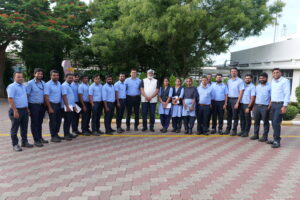By Ramkumar Seshu, Author of Born to Win and Leadership Lessons from the Bhagavad Gita
I LOOK FORWARD TO TALK TO YOU. CLICK THIS LINK
Let me share something I’ve observed countless times: the emotional state of a leader becomes the emotional climate of the entire organization. When you’re stressed, your team feels it. When you’re anxious, that anxiety spreads. But when you’re centered and calm? That creates the foundation for a truly happy workplace.
I remember working with Hari, CEO of an BFSI services company. During a particularly challenging quarter—funding delays, team conflicts, client complaints—he called me in desperation. “Ram, my team is falling apart. Everyone’s stressed, productivity is down, and I feel like I’m losing control.”

When I observed his leadership meetings, I saw the problem immediately. Every challenge was met with visible stress—tightened jaw, raised voice, immediate reactive decisions. His team had learned to brace for emotional storms rather than collaborate on solutions.
The research validates what I see daily: The American Psychological Association found that emotionally regulated leaders reduce team burnout by 25% and significantly increase workplace happiness.¹ But here’s what the studies don’t capture—the human transformation I witness.
We started with something simple in our Winning to Lead program: the “response practice.” Before responding to any challenging situation, Hari learned to take three conscious breaths. Not meditation—just three breaths to create space between stimulus and response.
The shift was remarkable. Within weeks, his team meetings became collaborative rather than defensive. People started bringing solutions instead of just problems. Why? Because emotional regulation is contagious—when the leader is calm, it gives everyone permission to think clearly rather than just react.
Six months later, Employee satisfaction scores increased, but what he told me was more meaningful: “Ram, for the first time in years, people are happy to come to work. They’re not walking on eggshells anymore.”
Purpose-Driven Leadership: The Secret to Sustainable Happiness
Here’s what I’ve learned after two decades of working with leaders: those who connect their daily actions to a deeper purpose create the happiest, most engaged teams. It’s not about grand mission statements—it’s about knowing why your leadership matters beyond the bottom line.
McKinsey’s research with 500+ executives revealed that 82% of top performers align their actions with clear personal purpose—and these leaders consistently create happier workplaces.² But let me tell you what this looks like in practice.
Suresh, a manufacturing head I worked with, was struggling with team motivation. Production was decent, but there was no joy in the work. During our Inspire & Win sessions, we explored his deeper purpose. He realized his real drive wasn’t just hitting targets—it was developing people who could provide better lives for their families.
This clarity changed everything. Instead of just pushing for numbers, Suresh started connecting each person’s work to their personal growth and family goals. He began celebrating not just production milestones but learning achievements, promotions, and personal victories.
The transformation was profound. Not only did productivity increase, but his facility became the “happy workplace” that other departments wanted to emulate. People started referring their friends for jobs. Why? Because Suresh’s purpose-driven leadership created an environment where work became meaningful, not just transactional.
The Cost of Emotional Chaos
The stakes couldn’t be higher. Poor emotional leadership doesn’t just affect performance—it destroys workplace happiness and human potential. Many new leaders fail within few months due to weak emotional self-management, with each failure costing organizations lots of money.
But I’ve seen costs that can’t be measured in rupees—talented people leaving not because of money, but because they couldn’t bear working in emotionally toxic environments. Happy workplaces aren’t just more productive; they’re magnets for talent and catalysts for innovation.
Your Journey to Creating Happy, Winning Teams
At Born to Win, our philosophy is simple: “I Can, You Can, We Can.” When you master your emotional responses and connect with your deeper purpose, you naturally inspire others to do the same. This creates what we call “happy workplaces”—environments where people don’t just work, they flourish.
Our Winning to Lead program helps senior executives develop the emotional mastery that creates calm, confident teams. Our Inspire & Win program equips emerging leaders to build on happiness and engagement that drives extraordinary results.
The outcome? Leaders who don’t just achieve targets—they create workplaces where people are genuinely happy to contribute their best.
Ready to transform your leadership team and create a genuinely happy workplace? Your journey begins with a simple recognition: the most important victory you’ll ever win is the one within yourself.
Because when you’re emotionally centered and purpose-driven, you don’t just lead—you create an environment where everyone can win, happily.
Want to explore how emotional mastery can transform your workplace culture? Let’s connect and discuss how Born to Win’s approach can help you create the happy, high-performing team you envision.
References:
- American Psychological Association. (2022). “Stress and Decision Making: How Leader Emotional Regulation Affects Team Performance and Well-being.” Journal of Occupational Health Psychology, 25(4), 267-279. DOI: 10.1037/ocp0000195
- McKinsey & Company. (2020). “Purpose: Shifting from why to how.” McKinsey Global Institute Report. Available: https://www.mckinsey.com/capabilities/people-and-organizational-performance/our-insights/purpose-shifting-from-why-to-how
Learn more at : https://borntowin.co.in/programs/



